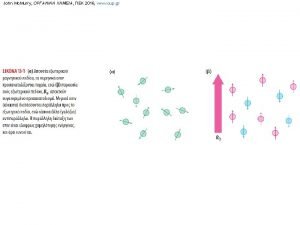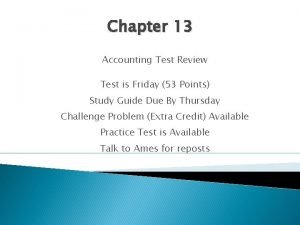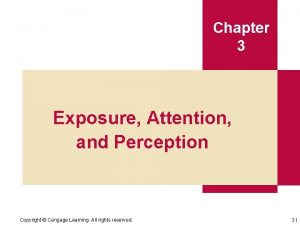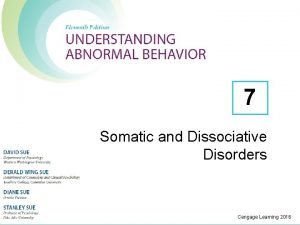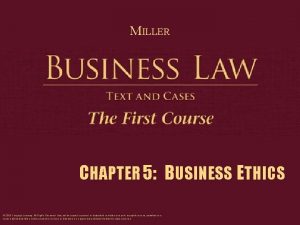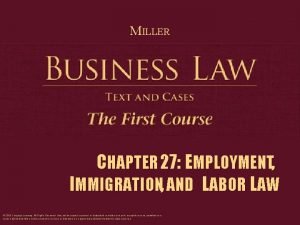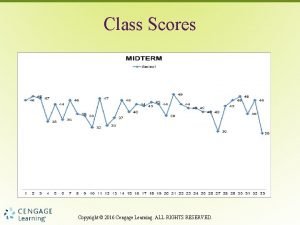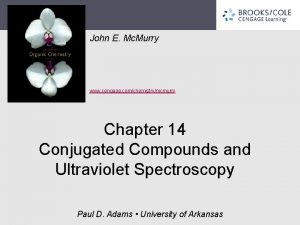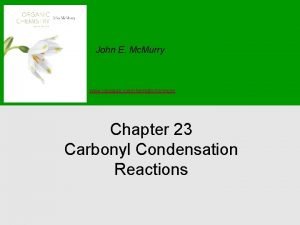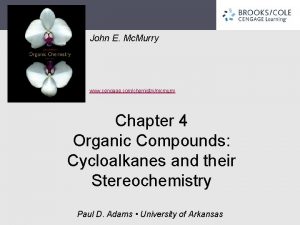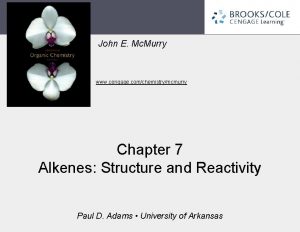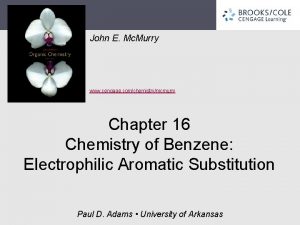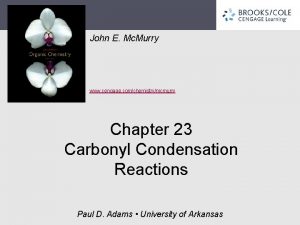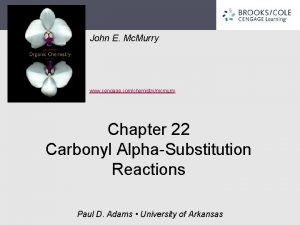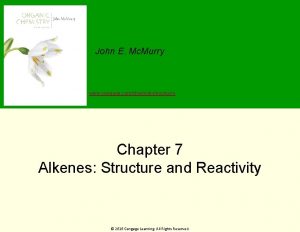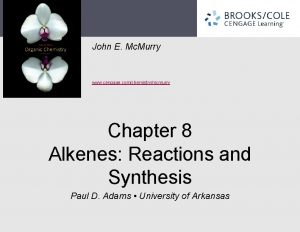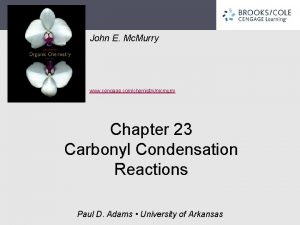John E Mc Murry www cengage comchemistrymcmurry Chapter




























































- Slides: 60

John E. Mc. Murry www. cengage. com/chemistry/mcmurry Chapter 2 Polar Covalent Bonds; Acids and Bases © 2016 Cengage Learning. All Rights Reserved.

Learning Objectives (2. 1) Polar covalent bonds: Electronegativity (2. 2) Polar covalent bonds: Dipole moments (2. 3) Formal charges (2. 4) Resonance (2. 5) Rules for resonance forms © 2016 Cengage Learning. All Rights Reserved.

Learning Objectives (2. 6) Drawing resonance forms (2. 7) Acids and bases: The Brønsted–Lowry definition (2. 8) Acid and base strength (2. 9) Predicting acid–base reactions from p. Ka values (2. 10) Organic acids and organic bases © 2016 Cengage Learning. All Rights Reserved.

Learning Objectives (2. 11) Acids and bases: The Lewis definition (2. 12) Noncovalent interactions between molecules © 2016 Cengage Learning. All Rights Reserved.

Polar Covalent Bonds: Electronegativity Covalent bonds can have ionic character Polar covalent bonds: Bonding electrons are attracted more strongly by one atom than by the other Electron distribution between atoms is not symmetrical © 2016 Cengage Learning. All Rights Reserved.

Electronegativity Intrinsic ability of an atom to attract the shared electrons in a covalent bond Differences in EN produce bond polarity F is most electronegative (EN = 4. 0), Cs is least (EN = 0. 7) Metals on left side of periodic table attract electrons weakly Halogens and other reactive nonmetals on right side of periodic table attract electrons strongly EN of C = 2. 5 © 2016 Cengage Learning. All Rights Reserved.

Figure 2. 2 - Electronegativity Values and Trends © 2016 Cengage Learning. All Rights Reserved.

Bond Polarity and Inductive Effect Difference in EN of atoms < 2 in polar covalent bonds Difference in EN > 2 in ionic bonds C–H bonds are relatively nonpolar C–O, C–X bonds are polar Bonding electrons toward electronegative atom C acquires partial positive charge, + Electronegative atom acquires partial negative charge, Inductive effect: Shifting of electrons in a σ bond in response to EN of nearby atoms © 2016 Cengage Learning. All Rights Reserved.

Electrostatic Potential Maps Show calculated charge distributions Colors indicate electron-rich (red) and electron-poor (blue) regions Arrows indicate direction of bond polarity © 2016 Cengage Learning. All Rights Reserved.

Worked Example Which element in each of the following pairs is more electronegative? (a) Li or H (b) Cl or I Solution: Using Figure 2. 2 (a) Li (1. 0) is less electronegative when compared to H (2. 1) (b) Cl (3. 0) is more electronegative when compared to I (2. 5) © 2016 Cengage Learning. All Rights Reserved.

Polar Covalent Bonds: Dipole Moments Molecules are often polar from vector summation of individual bond polarities and lone -pair contributions Strongly polar substances are soluble in polar solvents like water Nonpolar substances are insoluble in water Dipole moment ( ): Net molecular polarity, due to difference in summed charges - Magnitude of charge Q at end of molecular dipole times distance r between charges © 2016 Cengage Learning. All Rights Reserved.

Polar Covalent Bonds: Dipole Moments = Q r, in debyes (D), 1 D = 3. 336 10 -30 coulomb meter Length of an average covalent bond, the dipole moment would be 1. 60 × 10 -29 C m, or 4. 80 D © 2016 Cengage Learning. All Rights Reserved.

Dipole Moments in Water and Ammonia Large dipole moments EN of O and N > H Both O and N have lone-pair electrons oriented away from all nuclei © 2016 Cengage Learning. All Rights Reserved.

Absence of Dipole Moments In symmetrical molecules, the dipole moments of each bond have one in the opposite direction The effects of the local dipoles cancel each other © 2016 Cengage Learning. All Rights Reserved.

Worked Example Draw three-dimensional drawing of H 2 C═CH 2 molecules Predict whether it has dipole moment Solution: Drawing an arrow that points from the least electronegative element to the most electronegative element Has zero dipole moment © 2016 Cengage Learning. All Rights Reserved.

Formal Charges At times it is necessary to have structures with formal charges on individual atoms Bonding of the atom in the molecule is compared to valence electron structure © 2016 Cengage Learning. All Rights Reserved.

Formal Charge for Dimethyl Sulfoxide Atomic sulfur has 6 valence electrons Dimethyl sulfoxide sulfur has only 5 It has lost an electron and has positive charge © 2016 Cengage Learning. All Rights Reserved.

Table 2. 2 - A Summary of Common Formal Charges © 2016 Cengage Learning. All Rights Reserved.

Worked Example Calculate formal charges on the four O atoms in the methyl phosphate dianion Solution: # of valence electrons © 2016 Cengage Learning. All Rights Reserved. # of nonbonding electrons

Worked Example For oxygen 1: For oxygen 2: For oxygen 3: © 2016 Cengage Learning. All Rights Reserved.

Worked Example For oxygen 4: Formal charge of oxygen atoms 1 and 2 is 0 Formal charge of oxygen atoms 3 and 4 is -1 © 2016 Cengage Learning. All Rights Reserved.

Resonance Some molecules have structures that cannot be shown with a single representation Represented by structures that contribute to the final structure but differ in the position of the bond or lone pair Such structures are delocalized and are represented by resonance forms © 2016 Cengage Learning. All Rights Reserved.

Resonance Hybrids Structure with resonance forms, that does not alternate between the forms Example - Benzene (C 6 H 6) has two resonance forms with alternating double and single bonds Is a hybrid of the two individual forms All six carbon–carbon bonds are equivalent © 2016 Cengage Learning. All Rights Reserved.

Rules for Resonance Forms Individual resonance forms are imaginary Real structure is a hybrid of different forms Resonance forms differ only in the placement of their or nonbonding electrons Curved arrow indicates movement of electrons, not of the atoms © 2016 Cengage Learning. All Rights Reserved.

Rules for Resonance Forms Different resonance forms of a substance do not have to be equivalent When two resonance forms are nonequivalent, the actual structure of the resonance hybrid resembles the more stable form Resonance forms obey normal rules of valency Resonance hybrid is more stable than any individual resonance form Resonance leads to stability © 2016 Cengage Learning. All Rights Reserved.

Drawing Resonance Forms Any three-atom grouping with a p orbital on each atom has two resonance forms © 2016 Cengage Learning. All Rights Reserved.

Drawing Resonance Forms Resonance forms differ by an exchange in position of the multiple bonds and the asterisk From one end of the three-atom grouping to the other Recognizing three-atom groupings within larger structures help generate resonance forms, symmetrically © 2016 Cengage Learning. All Rights Reserved.

2, 4 -Pentanedione Anion Has a lone pair of electrons Has a formal negative charge on the central carbon atom, next to a C═O bond on the left and on the right Has three resonance structures © 2016 Cengage Learning. All Rights Reserved.

Worked Example Draw the indicated number of resonance forms for: The allyl cation, H 2 C═CH CH 22 - (2) Solution: Locating three-atom groupings that contain a multiple bond next to an atom with a p orbital Exchanging the positions of the bond and the electrons in the p orbital, we have: © 2016 Cengage Learning. All Rights Reserved.

Acids and Bases: The Brønsted. Lowry Definition Idea that acids are solutions containing a lot of “H+” and bases are solutions containing a lot of “OH-” is not very useful in organic chemistry Brønsted-Lowry theory defines acids and bases by their role in reactions that transfer protons (H+) between donors and acceptors © 2016 Cengage Learning. All Rights Reserved.

Acids and Bases: The Brønsted. Lowry Definition Brønsted-Lowry acid: Substance that donates a hydrogen ion, H+ Brønsted-Lowry base: Substance that accepts a hydrogen ion, H+ Proton is a synonym for H+ Loss of valence electron from H leaves only the nucleus—a proton © 2016 Cengage Learning. All Rights Reserved.

Acids and Bases: The Brønsted. Lowry Definition Conjugate base: Product that results from deprotonation of a Brønsted-Lowry acid Conjugate acid: Product that results from protonation of a Brønsted-Lowry base © 2016 Cengage Learning. All Rights Reserved.

Acid Base Strength Acidity constant (Ka): Measure of acid strength For the reaction of an acid (HA) with water to form hydronium ion Conjugate base (A-) is a measure related to the strength of the acid Brackets [ ] indicate concentration in moles per liter © 2016 Cengage Learning. All Rights Reserved.

Acid and Base Strength Acid strengths are normally expressed using p. Ka values p. Ka: Negative common logarithm of the Ka Stronger acids have smaller p. Ka Weaker acids have larger p. Ka © 2016 Cengage Learning. All Rights Reserved.

Acid and Base Strength Water is both an acid and base solvent Ion product of water, Kw = [H 3 O+][OH-] Molar concentration of pure water, [H 2 O] = 55. 4 M at 25°C © 2016 Cengage Learning. All Rights Reserved.

Table 2. 3 - Relative Strengths of Some Common Acids and Their Conjugate Bases © 2016 Cengage Learning. All Rights Reserved.

Worked Example The amino acid phenylalanine has p. Ka = 1. 83, and tryptophan has p. Ka = 2. 83 Which is the stronger acid? Solution: Stronger acid has a smaller p. Ka and a weaker acid has a larger p. Ka Accordingly, phenylalanine (p. Ka = 1. 83) is a stronger acid than tryptophan (p. Ka = 2. 83) © 2016 Cengage Learning. All Rights Reserved.

Predicting Acid-Base Reactions from p. Ka Values p. Ka values are related as logarithms to equilibrium constants Useful for predicting whether a given acid-base reaction will take place Difference in two p. Ka values is the log of the ratio of equilibrium constants, and can be used to calculate the extent of transfer © 2016 Cengage Learning. All Rights Reserved.

Predicting Acid-Base Reactions from p. Ka Values © 2016 Cengage Learning. All Rights Reserved.

Worked Example Will the following reaction take place to a significant extent as written, according to the data in Table 2. 3? HCN + CH 3 CO 2 - Na+ → Solution: HCN + CH 3 CO 2 ? - Na+ -CN + CH 3 CO 2 H ? → Na+ -CN + CH 3 CO 2 H p. Ka= 4. 7 Stronger acid p. Ka= 9. 3 Weaker acid Since CH 3 CO 2 H is stronger than HCN the reaction will not take place to a significant extent the direction written © 2016 Cengage Learning. All Rights Reserved.

Organic Acids Characterized by the presence of positively polarized hydrogen atom © 2016 Cengage Learning. All Rights Reserved.

Organic Acids Two main kinds, those that contain: Hydrogen atom bonded to a electronegative oxygen atom(O–H) A hydrogen atom bonded to a carbon atom next to a C═O bond(O═C─C─H) © 2016 Cengage Learning. All Rights Reserved.

Organic Bases Have an atom with a lone pair of electrons that can bond to H+ Nitrogen-containing compounds derived from ammonia are the most common organic bases Oxygen-containing compounds can react as bases with a strong acid or as acids with strong bases © 2016 Cengage Learning. All Rights Reserved.

Acids and Bases: The Lewis Definition Lewis acid: Electron pair acceptors Lewis bases: Electron pair donors Brønsted acids are not Lewis acids because they cannot accept an electron pair directly © 2016 Cengage Learning. All Rights Reserved.

Lewis Acids and the Curved Arrow Formalism Lewis definition of acidity includes metal cations, such as Mg 2+ They accept a pair of electrons when they form a bond to a base Group 3 A elements, such as BF 3 and Al. Cl 3, are Lewis acids Have unfilled valence orbitals and can accept electron pairs from Lewis bases © 2016 Cengage Learning. All Rights Reserved.

Lewis Acids and the Curved Arrow Formalism Transition-metal compounds, such as Ti. Cl 4, Fe. Cl 3, Zn. Cl 2, and Sn. Cl 4, are Lewis acids Curved arrow means that a pair of electrons move from the atom at the tail of the arrow to the atom at the head of the arrow © 2016 Cengage Learning. All Rights Reserved.

Figure 2. 5 - The Reaction of Boron Trifluoride with Dimethyl Ether © 2016 Cengage Learning. All Rights Reserved.

Lewis Bases Compound with a pair of nonbonding electrons that it can use to bond to a Lewis acid Can accept protons as well as Lewis acids Definition encompasses that for Brønsted bases Oxygen-and nitrogen-containing organic compounds are Lewis bases; they have lone pairs of electrons Some compounds can act as both acids and bases © 2016 Cengage Learning. All Rights Reserved.

Lewis Bases © 2016 Cengage Learning. All Rights Reserved.

Worked Example Using curved arrows, show acetaldehyde, CH 3 CHO, can act as a Lewis base Solution: A Lewis base donates an electron pair to a Lewis acid Using a curved arrow to show the movement of a pair toward the H atom of the acid © 2016 Cengage Learning. All Rights Reserved.

Noncovalent Interactions Between Molecules Noncovalent interactions: One of a variety of nonbonding interactions between molecules Dipole–dipole forces Dispersion forces Hydrogen bonds © 2016 Cengage Learning. All Rights Reserved.

Dipole–Dipole Forces Occur between polar molecules as a result of electrostatic interactions among dipoles Depending on orientation of the molecules, the forces can be either attractive or repulsive © 2016 Cengage Learning. All Rights Reserved.

Dispersion Forces Occur between all neighboring molecules Arise due to constant change in electron distribution within molecules © 2016 Cengage Learning. All Rights Reserved.

Hydrogen Bond Forces are the result of attractive interaction between a hydrogen bonded to an electronegative O or N atom and an unshared electron pair on another O or N atom © 2016 Cengage Learning. All Rights Reserved.

A Deoxyribonucleic Acid Segment © 2016 Cengage Learning. All Rights Reserved.

Worked Example Of the two vitamins A and C, one is hydrophilic and water-soluble while the other is hydrophobic and fat-soluble Which is which? © 2016 Cengage Learning. All Rights Reserved.

Worked Example Solution: Vitamin C has several polar ─OH groups that can form hydrogen bonds with water It is water soluble(hydrophilic) Most of Vitamin A’s atoms can’t form hydrogen bonds with water It is fat-soluble(hydrophobic) © 2016 Cengage Learning. All Rights Reserved.

Summary Organic molecules often have polar covalent bonds as a result of unsymmetrical electron sharing caused by differences in the electronegativity of atoms Polarity of a molecule is measured by its dipole moment, (+) and ( ) indicate formal charges on atoms in molecules to keep track of valence electrons around an atom © 2016 Cengage Learning. All Rights Reserved.

Summary Some substances must be shown as a resonance hybrid of two or more resonance forms that differ by the location of electrons A Brønsted(–Lowry) acid donates a proton A Brønsted(–Lowry) base accepts a proton Strength of Brønsted acid is related to the negative logarithm of the acidity constant, p. Ka Weaker acids have higher values of p. Ka © 2016 Cengage Learning. All Rights Reserved.

Summary Lewis acid has an empty orbital that can accept an electron pair Lewis base can donate an unshared electron pair Noncovalent interactions have several types – Dipole–dipole, dispersion, and hydrogen bond forces © 2016 Cengage Learning. All Rights Reserved.
 Mc murry
Mc murry Chapter 7:10 respitory system
Chapter 7:10 respitory system Cengage chapter 7
Cengage chapter 7 Chapter 13 medical math
Chapter 13 medical math Accounting chapter 13
Accounting chapter 13 Copyright cengage learning. powered by cognero
Copyright cengage learning. powered by cognero Chapter 5 the cardiovascular system labeling exercises
Chapter 5 the cardiovascular system labeling exercises Cengage chapter 8 answers
Cengage chapter 8 answers Alges root word
Alges root word Chapter 4 the muscular system labeling exercises
Chapter 4 the muscular system labeling exercises Prescription terms
Prescription terms Cengage differential equations
Cengage differential equations Century 21 bank
Century 21 bank Cengage differential equations
Cengage differential equations 2009 delmar cengage learning
2009 delmar cengage learning Cengage learning heart diagram
Cengage learning heart diagram Cengage
Cengage Cengage
Cengage Cengage
Cengage South-western cengage learning
South-western cengage learning Cengage
Cengage Cengage
Cengage Mongols
Mongols 2009 delmar cengage learning
2009 delmar cengage learning Cengage learning heart diagram
Cengage learning heart diagram Challenge word building medical terminology
Challenge word building medical terminology Cengage learning australia
Cengage learning australia Graphing tpr
Graphing tpr Whille
Whille Cengage learning
Cengage learning Module 5 computer concepts exam
Module 5 computer concepts exam Halpert's dimensions of charisma
Halpert's dimensions of charisma Wadsworth cengage learning
Wadsworth cengage learning Compression approach to innovation
Compression approach to innovation Cengage learning
Cengage learning Cengage
Cengage Cengage learning plant cell
Cengage learning plant cell Cengage
Cengage Cengage learning
Cengage learning Motivation, ability, and opportunity consumer behaviour
Motivation, ability, and opportunity consumer behaviour Cengage learning
Cengage learning Consumer diversity in consumer behaviour
Consumer diversity in consumer behaviour Dissociative
Dissociative Brooks cole cengage learning
Brooks cole cengage learning Cengage interview process
Cengage interview process Cengage
Cengage Cengage
Cengage Word module 2 creating a research paper
Word module 2 creating a research paper Geometric sequence function
Geometric sequence function Cengage intro to business
Cengage intro to business 2014 cengage learning accounting answers
2014 cengage learning accounting answers Cengage
Cengage All rights reserved formula
All rights reserved formula Cengage layoffs
Cengage layoffs Kramer formulasi
Kramer formulasi Cengage.com
Cengage.com Cengage learning
Cengage learning Webassign cu boulder
Webassign cu boulder Cengage learning
Cengage learning 2009 delmar cengage learning
2009 delmar cengage learning Cengage.com
Cengage.com
